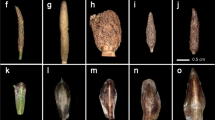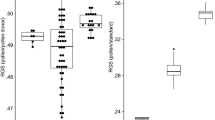Abstract
Intergeneric hybridizations were made betweenT. elongatum, and twoPsathyrostachys and fiveLeymus species. The seed set obtained onT. elongatum ×Leymus hybrids ranged from 5.65% to 20.00%, depending onLeymus species. The seed set obtained onT. elongatum ×Psathyrostachys hybrids ranged from 16.07% to 19.70%. Meiotic pairing at metaphase-I in JN diploid hybrids ofT. elongatum ×Psathyrostachys species revealed a very low level homology between the basic J and N genomes, and further demonstrated that the two genomes are quite diverged. Chromosome pairing in theT. elongatum ×Leymus secalinus hybrid averaged 15.19 univalents + 2.62 rod bivalents + 0.26 ring bivalents + 0.02 trivalents, suggesting that the partial Je chromosomes ofT. elongatum has homology withLeymus secalinus genomes.L. secalinus might have 3–4 chromosomes originating from Je genome.
Similar content being viewed by others
References
Dewey, D. R., 1970: Genome relations among diploidElymus junceus and certain tetraploid and octoploidElymus species. — Amer. J. Bot.57: 633–639.
, 1972a: Cytogenetics of tetraploidElymus cinereus, E. triticoides, E. multicaulis, E. karataviensis, and their F1 hybrids. — Bot. Gaz.133: 51–57.
, 1972b: Genome analysis of hybrids between diploidElymus junceus and five tetraploidElymus species. — Bot. Gaz.133: 415–420.
, 1976: The genome constitution and phylogeny ofElymus ambiguus. — Amer. J. Bot.63: 626–634.
, 1984: The genomic system of classification as a guide to intergeneric hybridization with the perennialTriticeae. — InGustafson, J. P., (Ed.): Gene manipulation in plant improvement, pp. 209–280. — New York: Plenum.
Jones, G. H., 1969: Further correlations between chiasmata and U-type exchanges in rye meiosis. — Chromosoma26: 105–118.
Löve, A., 1980: Chromosome number reports. LXVII.Poaceae-Triticeae. — Taxon29: 350–351.
, 1984: Conspectus of theTriticeae. — Feddes Repert.95: 425–521.
Ørgaard, M., Heslop-Harrison, J. S., 1994a: Relationships between species ofLeymus, Psathyrostachys, andHordeum (Poaceae, Triticeae) inferred from Southern hybridization of genomic and cloned DNA probes. — Pl. Syst. Evol.189: 217–231.
, 1994b: Investigations of genome relationships betweenLeymus, Psathyrostachys andHordeum inferred by genomic DNA: DNA in situ hybridization. — Ann. Bot.73: 195–203.
Petrova, K. A., 1970: Morphological and cytological investigation ofAgropyron elongatum (Host.) P. B. 2n = 14 ×Elymus mollis Trin. 2n = 28; F1 hybrids and amphidiploids. — In: Otdalen gibridiz i poliploidiya, pp. 158–176. — Moscow: USSR Nauka.
Sun, G. L., Yang, W. Y., Yu, S. Z., 1992a: Studies on embryo culture of intergeneric and interspecific hybrids inTriticeae. — J. Sichuan Agric. Univ.10: 666–672.
-Yen, C., Yang, J. L., 1992b: Cytogenetic studies of the intergeneric hybrids betweenLeymus secalinus (Georgi)Tzvelev and twoPsathyrostachys species (Triticeae: Poaceae). — The second Sino-Japanese symposium on plant chromosome research, pp. 467–471.
, 1995: Morphology and cytology of intergeneric hybrids involvingLeymus multicaulis (Poaceae). — Pl. Syst. Evol.194: 83–91.
Wang, R. R.-C., 1985: Genomic analysis ofThinopyrum bessarabicum andT. elongatum. — Canad. J. Genet. Cytol.27: 722–728.
, 1990: Intergeneric hybrids betweenThinopyrum andPsathyrostachys (Triticeae). — Genome33: 845–849.
, 1990: Meiotic associations at metaphase I in diploid, triploid, and tetraploid Russian Wildrye [Psathyrostachys juncea (Fisch.)Nevski]. — Cytologia55: 639–643.
, 1984: Morphology and cytology of interspecific hybrids ofLeymus mollis. — J. Heredity75: 488–492.
, 1989: Genome relationship betweenThinopyrum bessarabicum andT. elongatum: revisited. — Genome32: 802–809.
, 1994: Absence of the J genome inLeymus species (Poaceae: Triticeae): evidence from DNA hybridization and meiotic pairing. — Genome37: 231–235.
Zhang, H. B., Dvořák, J., 1991: The genome origin of tetraploid species ofLeymus (Poaceae: Triticeae) inferred from variation in repeated nucleotide sequences. — Amer. J. Bot.78: 871–884.
Author information
Authors and Affiliations
Rights and permissions
About this article
Cite this article
Sun, GL., Wu, BH. & Liu, F. Cytogenetic and genomic relationships ofThinopyrum elongatum with twoPsathyrostachys species and withLeymus secalinus (Poaceae). Pl Syst Evol 197, 225–231 (1995). https://doi.org/10.1007/BF00984641
Received:
Revised:
Accepted:
Issue Date:
DOI: https://doi.org/10.1007/BF00984641




